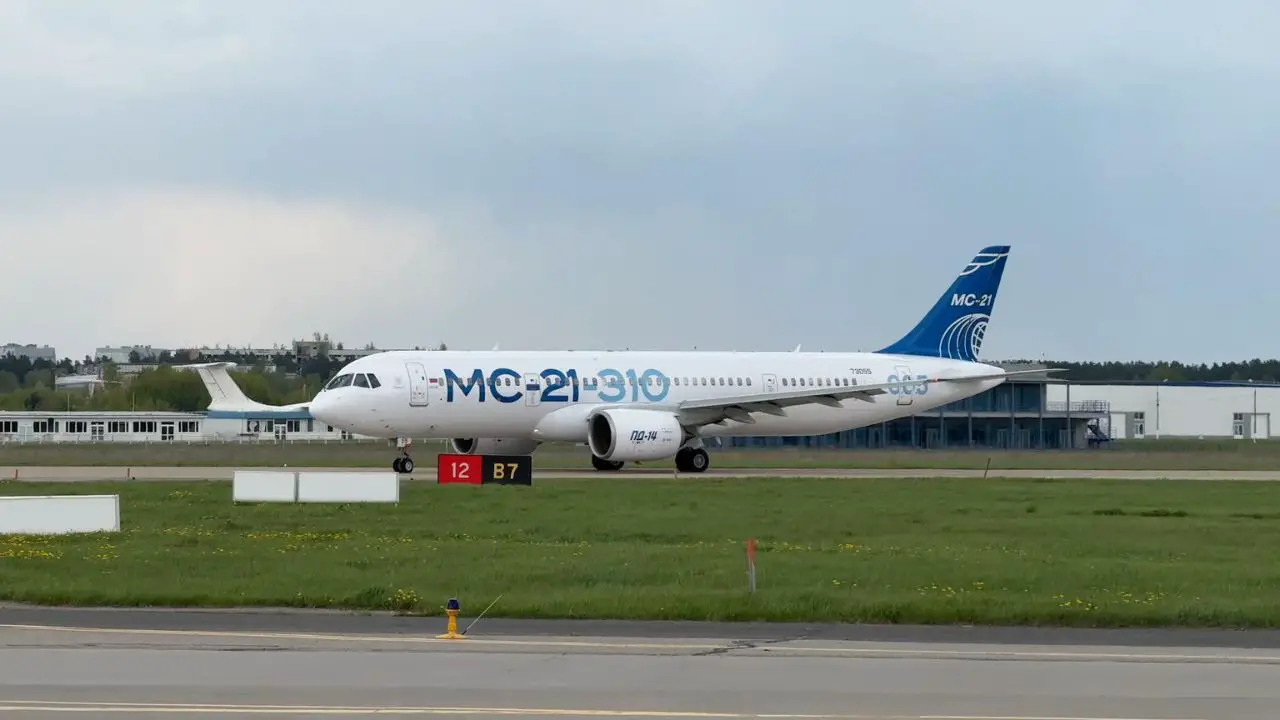At the Gromov Flight Research Institute airfield “Ramenskoye,” a prototype of the medium-range MC-21-310, which has been equipped with new Russian systems and components, has arrived from Irkutsk to continue its certification flight training. There were no reported issues during the non-stop flight. This model is the first of two aircraft that will be used in the certification flight program.
The flight distance between Irkutsk and Zhukovsky is approximately 4,500 kilometers (2,796 miles). This is the distance covered during a test flight of the Russian-built MC-21-300 aircraft in October 2017. The flight took six hours at an altitude of 10,000 meters.
Gromov Flight Research Institute (GFRI) aerodrome, which is also known as “Ramenskoye,” is one of Russia’s most significant aviation facilities. The aerodrome, in Zhukovsky, is located approximately 40 kilometers southeast of Moscow and is the epicenter of Russian aerospace research, aircraft testing, and technological innovation. The GFRI has been instrumental in the development and testing of virtually every major Soviet and Russian aircraft since its establishment in 1941, serving as the primary test base for the nation’s leading aircraft design bureaus.
Ramenskoye airfield was instrumental in the Cold War, as a testing site for advanced prototypes and experimental aircraft. It was chosen as a secondary landing site for the Buran space shuttle and served as the location for flight tests of the Buran aerodynamic prototype, which underscored its strategic significance in the realm of space exploration. The airfield’s legacy is profoundly connected to the technological advancements of the Soviet Union and, subsequently, Russia, in both military and civilian aviation.
The facilities at Ramenskoye are of the highest quality, boasting three concrete runways, one of which is the longest in Europe, with a length of 5.4 kilometers and a width of 120 meters. Some of the most remarkable accomplishments in aviation history have been performed on this vast runway, including the takeoff and touchdown of the An-225 “Mriya” carrying the Buran orbiter. The airfield’s infrastructure also includes a vast aerial flight test zone, sophisticated data processing capabilities, and advanced air traffic control systems, which facilitate secure and precise flight testing in all weather conditions.
One cannot exaggerate GFRI’s significance in the Russian aviation industry. The institute collaborates closely with other research organizations, such as the Central Aerohydrodynamic Institute (TsAGI), and is instrumental in the certification and development of new aircraft, helicopters, and aviation systems. It has been the site of state and factory testing for both military and civilian aviation projects and has facilitated the creation of iconic aircraft, such as the Ilyushin IL-78 tanker, over the decades.
Ramenskoye has undergone a transformation in recent years to facilitate civilian use. It has been rebranded as Zhukovsky International Airport, and it is now servicing commercial flights. Its objective is to establish itself as a significant hub in the Moscow region. The airport’s expansion initiative encompasses the construction of additional cargo facilities and passenger terminals, with the goal of accommodating up to 20 million passengers annually. Furthermore, the MAKS International Air Show, the largest aerospace exhibition in Russia, is held at the aerodrome, which attracts the attention of industry leaders and enthusiasts worldwide.
The MiG-21, MiG-25, MiG-29, Su-27, Il-76, Tu-144, and Mi-26 helicopters are among the impressive aircraft that have been tested and displayed at Ramenskoye. Until 2006, the institute also provided the public with the opportunity to fly in jet fighters, allowing them to experience the “Edge of Space” in aircraft such as the MiG-25 and MiG-29. Ramenskoye’s status as a hub for aviation excellence and adventure has been further solidified by these activities.
Since the first prototype’s arrival in 2017, following its maiden flight in Irkutsk, GFRI has served as the main location for flight testing for the MC-21 program. At GFRI, thorough tests were done on the MC-21 to check how stable and controllable it is, how well it takes off and lands, and how its engine works, including starting the engine in the air and recovering from difficult flying positions. Detailed evaluations of the aircraft’s composite wing and other innovations were facilitated by the institute’s facilities, which incorporated data from hundreds of sensors to inform design refinements and certification efforts. These evaluations were essential for the verification of technical solutions and the advancement toward international and Russian certification.
In the same vein, GFRI is at the forefront of evaluating the SJ-100 (Superjet New), the most recent iteration of the Sukhoi Superjet 100 that has undergone substantial import substitution. The prototype SJ-100, which consists of 97% Russian-made systems, was transferred to GFRI for its certification trials in 2024. The institute is responsible for executing over 200 test flights to verify the safety and performance of the new configuration. Initially, in 2024, the Franco-Russian SaM146 engines powered the configuration. In April, the model with Russian PD-8 engines began flying. The aircraft’s compliance with rigorous safety and operational standards is guaranteed by the evaluation of avionics, flight control, landing gear, and other critical systems by GFRI’s test pilots and facilities.
Official Website of Youtube Channel – Altitude Addicts
